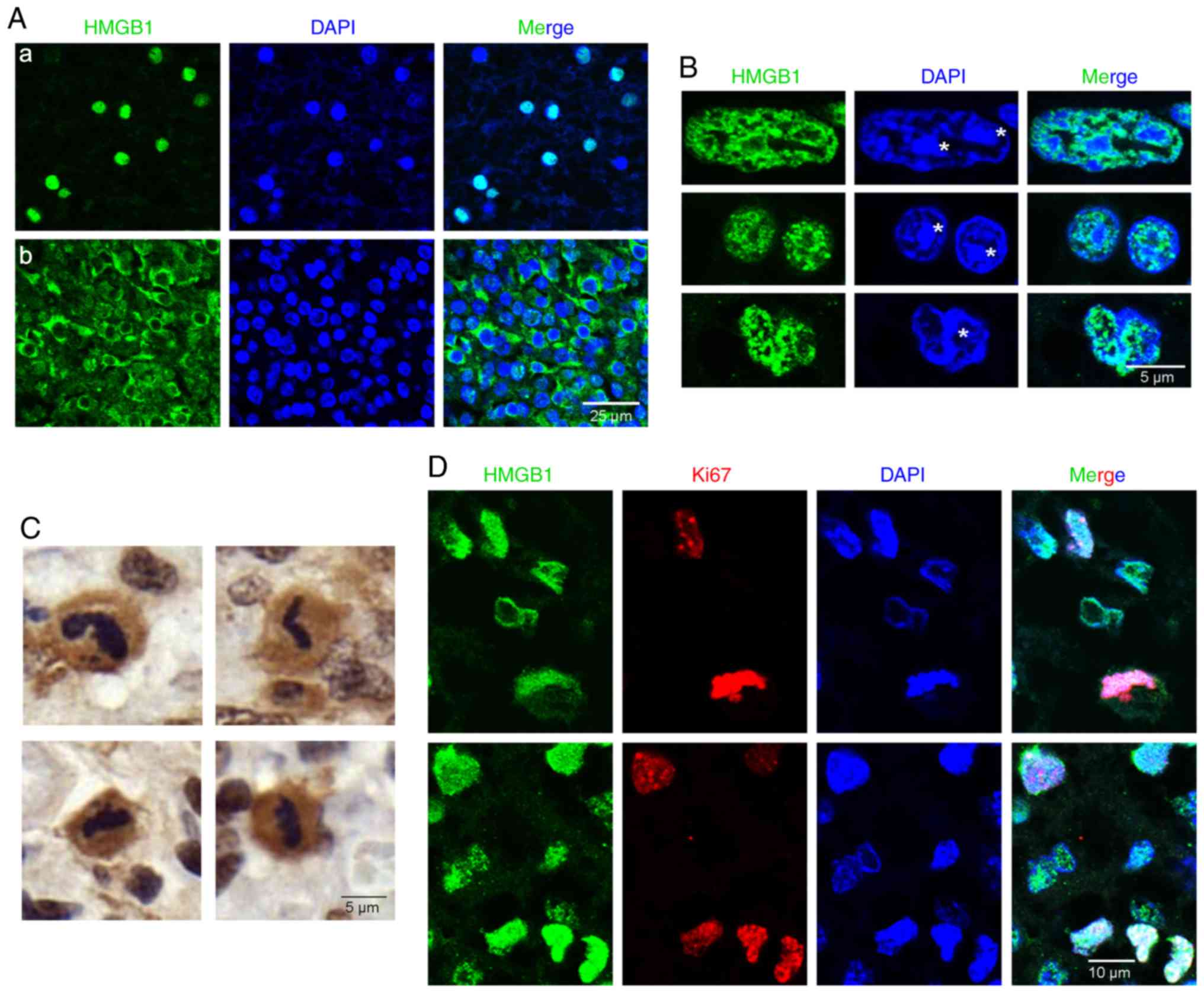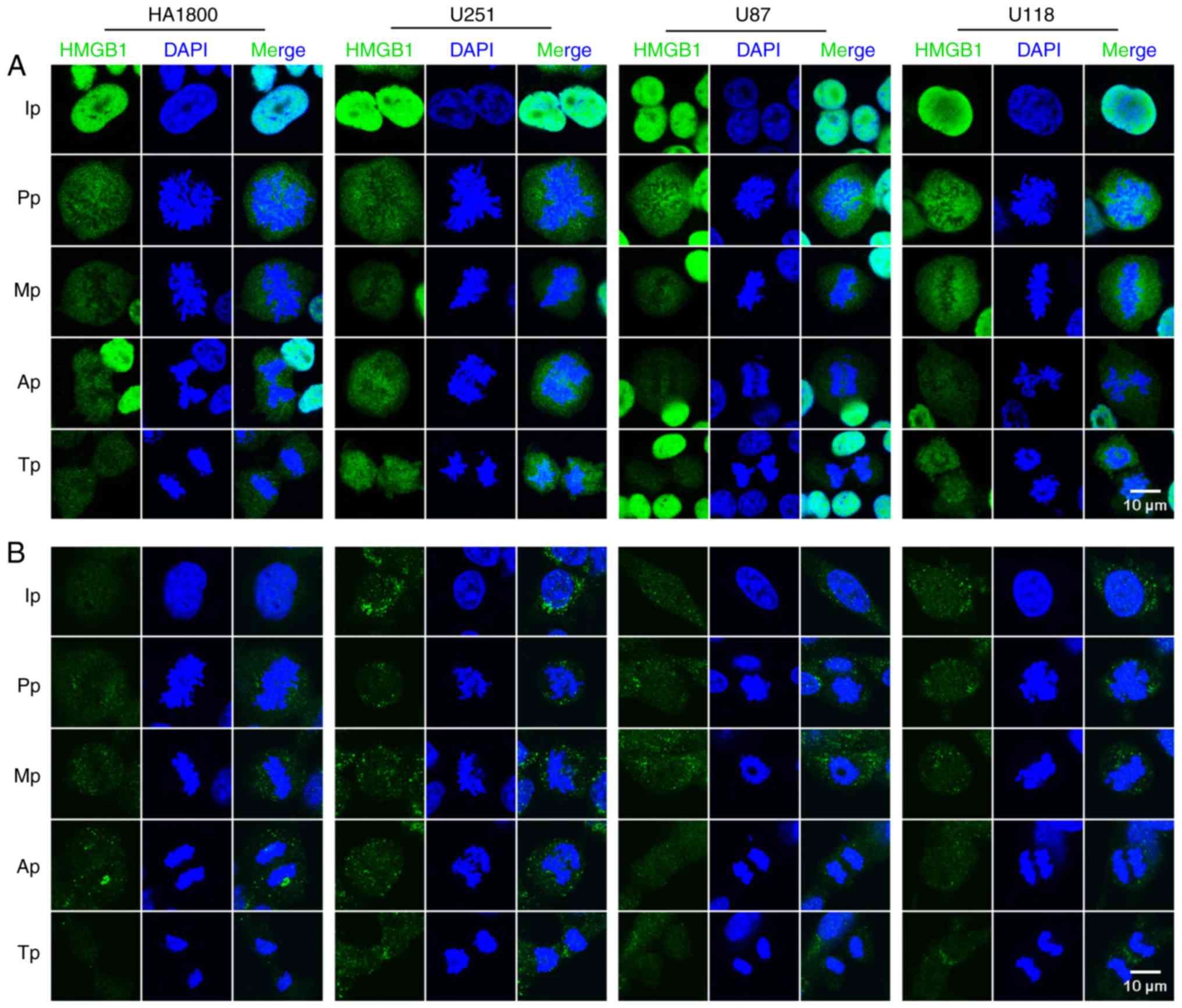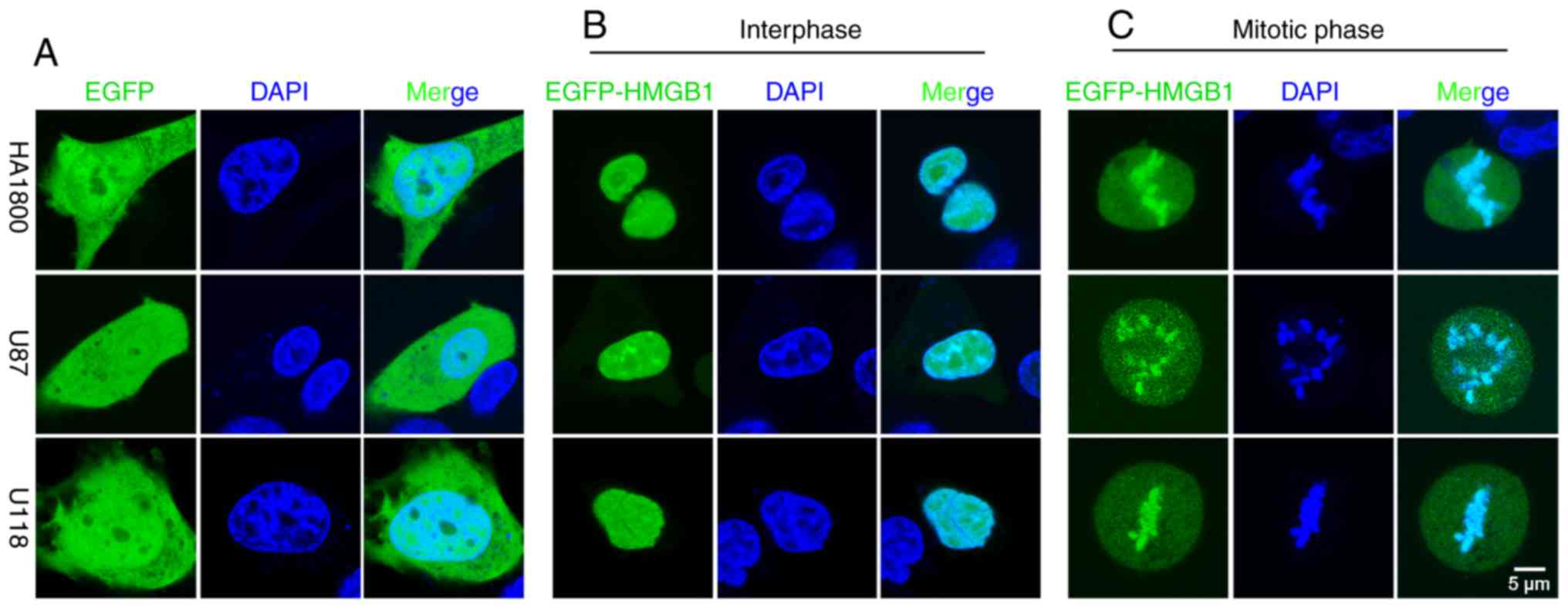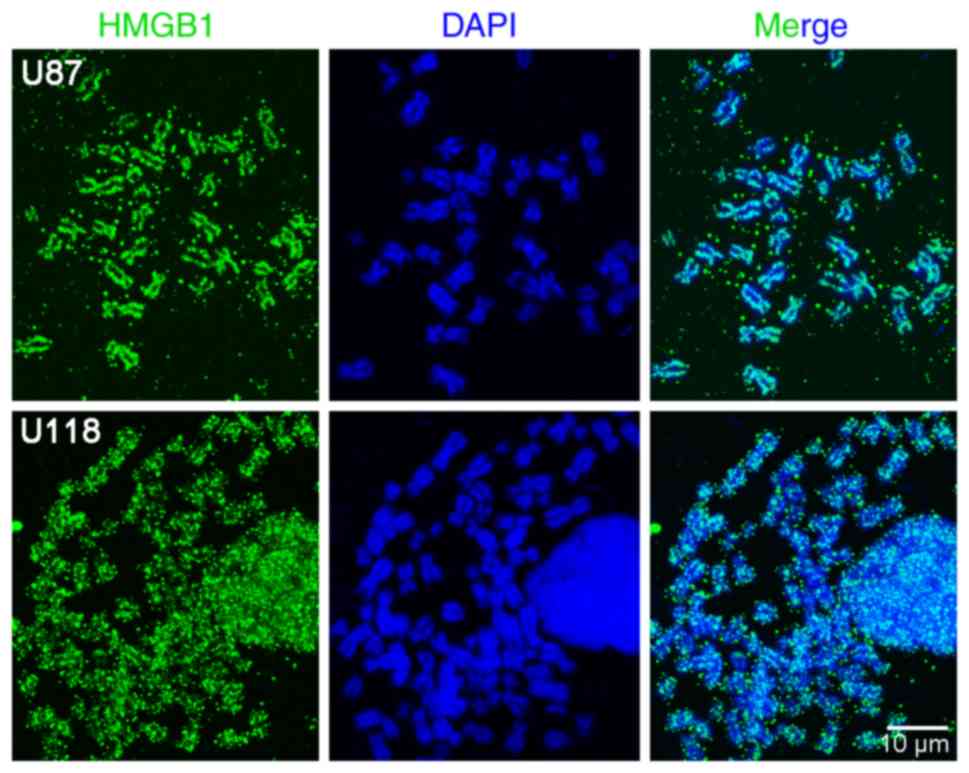|
1
|
Tang D, Kang R, Zeh HJ 3rd and Lotze MT:
High-mobility group box 1 and cancer. Biochim Biophys Acta.
1799:131–140. 2010. View Article : Google Scholar : PubMed/NCBI
|
|
2
|
Belgrano FS, de Abreu da Silva IC, Bastos
de Oliveira FM, Fantappie MR and Mohana-Borges R: Role of the
acidic tail of high mobility group protein B1 (HMGB1) in protein
stability and DNA bending. PLoS One. 8:e795722013. View Article : Google Scholar : PubMed/NCBI
|
|
3
|
Bianchi ME, Beltrame M and Paonessa G:
Specific recognition of cruciform DNA by nuclear protein HMG1.
Science. 243:1056–1059. 1989. View Article : Google Scholar : PubMed/NCBI
|
|
4
|
Park S and Lippard SJ: Redox
state-dependent interaction of HMGB1 and cisplatin-modified DNA.
Biochemistry. 50:2567–2574. 2011. View Article : Google Scholar : PubMed/NCBI
|
|
5
|
Jaouen S, de Koning L, Gaillard C,
Muselikova-Polanska E, Stros M and Strauss F: Determinants of
specific binding of HMGB1 protein to hemicatenated DNA loops. J Mol
Biol. 353:822–837. 2005. View Article : Google Scholar : PubMed/NCBI
|
|
6
|
Ugrinova I, Pashev IG and Pasheva EA:
Post-synthetic acetylation of HMGB1 protein modulates its
interactions with supercoiled DNA. Mol Biol Rep. 36:1399–1404.
2009. View Article : Google Scholar : PubMed/NCBI
|
|
7
|
Völp K, Brezniceanu ML, Bösser S, Brabletz
T, Kirchner T, Göttel D, Joos S and Zörnig M: Increased expression
of high mobility group box 1 (HMGB1) is associated with an elevated
level of the antiapoptotic c-IAP2 protein in human colon
carcinomas. Gut. 55:234–242. 2006. View Article : Google Scholar : PubMed/NCBI
|
|
8
|
Choi YR and Kim H, Kang HJ, Kim NG, Kim
JJ, Park KS, Paik YK, Kim HO and Kim H: Overexpression of high
mobility group box 1 in gastrointestinal stromal tumors with KIT
mutation. Cancer Res. 63:2188–2193. 2003.PubMed/NCBI
|
|
9
|
Wagner KU and Schmidt JW: The two faces of
Janus kinases and their respective STATs in mammary gland
development and cancer. J Carcinog. 10:322011. View Article : Google Scholar : PubMed/NCBI
|
|
10
|
Guerriero JL, Ditsworth D, Catanzaro JM,
Sabino G, Furie MB, Kew RR, Crawford HC and Zong WX: DNA alkylating
therapy induces tumor regression through an HMGB1-mediated
activation of innate immunity. J Immunol. 186:3517–3526. 2011.
View Article : Google Scholar : PubMed/NCBI
|
|
11
|
Kang R, Zhang Q, Zeh HJ 3rd, Lotze MT and
Tang D: HMGB1 in cancer: Good, bad, or both? Clin Cancer Res.
19:4046–4057. 2013. View Article : Google Scholar : PubMed/NCBI
|
|
12
|
Seidu RA, Wu M, Su Z and Xu H: Paradoxical
role of high mobility group Box 1 in glioma: A suppressor or a
promoter? Oncol Rev. 11:3252017. View Article : Google Scholar : PubMed/NCBI
|
|
13
|
Zhang J, Liu C and Hou R: Knockdown of
HMGB1 improves apoptosis and suppresses proliferation and invasion
of glioma cells. Chin J Cancer Res. 26:658–668. 2014.PubMed/NCBI
|
|
14
|
Gupta P, Ghosh S, Nagarajan A, Mehta VS
and Sen E: β-defensin-3 negatively regulates TLR4-HMGB1 axis
mediated HLA-G expression in IL-1β treated glioma cells. Cell
Signal. 25:682–689. 2013. View Article : Google Scholar : PubMed/NCBI
|
|
15
|
Cheng P, Ma Y, Gao Z and Duan L: High
mobility group box 1 (HMGB1) predicts invasion and poor prognosis
of glioblastoma multiforme via activating AKT signaling in an
autocrine pathway. Med Sci Monit. 24:8916–8924. 2018. View Article : Google Scholar : PubMed/NCBI
|
|
16
|
Prasad R, Liu Y, Deterding LJ, Poltoratsky
VP, Kedar PS, Horton JK, Kanno S, Asagoshi K, Hou EW, Khodyreva SN,
et al: HMGB1 is a cofactor in mammalian base excision repair. Mol
Cell. 27:829–841. 2007. View Article : Google Scholar : PubMed/NCBI
|
|
17
|
Jia L, Song Y, Song H, Wang G, Fan W, Li
X, Zheng H and Yao A: Overexpression of high mobility group box 1
(HMGB1) has no correlation with the prognosis in glioma. Biomark
Med. 13:851–863. 2019. View Article : Google Scholar : PubMed/NCBI
|
|
18
|
Li MW, Zhou L and Lam HM: Paraformaldehyde
fixation may lead to misinterpretation of the subcellular
localization of plant high mobility group box proteins. PLoS One.
10:e1350332015.
|
|
19
|
Pallier C, Scaffidi P, Chopineau-Proust S,
Agresti A, Nordmann P, Bianchi ME and Marechal V: Association of
chromatin proteins high mobility group box (HMGB) 1 and HMGB2 with
mitotic chromosomes. Mol Biol Cell. 14:3414–3426. 2003. View Article : Google Scholar : PubMed/NCBI
|
|
20
|
Kumar S, Chaturvedi NK, Kumar S and Tyagi
RK: Agonist-mediated docking of androgen receptor onto the mitotic
chromatin platform discriminates intrinsic mode of action of
prostate cancer drugs. Biochim Biophys Acta. 1783:59–73. 2008.
View Article : Google Scholar : PubMed/NCBI
|
|
21
|
Louis DN, Perry A, Reifenberger G, von
Deimling A, Figarella-Branger D, Cavenee WK, Ohgaki H, Wiestler OD,
Kleihues P and Ellison DW: The 2016 world health organization
classification of tumors of the central nervous system: A summary.
Acta Neuropathol. 131:803–820. 2016. View Article : Google Scholar : PubMed/NCBI
|
|
22
|
Bruno S and Darzynkiewicz Z: Cell cycle
dependent expression and stability of the nuclear protein detected
by Ki-67 antibody in HL-60 cells. Cell Prolif. 25:31–40. 1992.
View Article : Google Scholar : PubMed/NCBI
|
|
23
|
Wang Y, Jiang Z, Yan J and Ying S: HMGB1
as a potential biomarker and therapeutic target for malignant
mesothelioma. Dis Markers. 2019:41831572019. View Article : Google Scholar : PubMed/NCBI
|
|
24
|
Wu T, Zhang W, Yang G, Li H, Chen Q, Song
R and Zhao L: HMGB1 overexpression as a prognostic factor for
survival in cancer: A meta-analysis and systematic review.
Oncotarget. 7:50417–50427. 2016.PubMed/NCBI
|
|
25
|
Wang XJ, Zhou SL, Fu XD, Zhang YY, Liang
B, Shou JX, Wang JY and Ma J: Clinical and prognostic significance
of high-mobility group box-1 in human gliomas. Exp Ther Med.
9:513–518. 2015. View Article : Google Scholar : PubMed/NCBI
|
|
26
|
He SJ, Cheng J, Feng X, Yu Y, Tian L and
Huang Q: The dual role and therapeutic potential of high-mobility
group box 1 in cancer. Oncotarget. 8:64534–64550. 2017.PubMed/NCBI
|
|
27
|
Guo ZS, Liu Z, Bartlett DL, Tang D and
Lotze MT: Life after death: Targeting high mobility group box 1 in
emergent cancer therapies. Am J Cancer Res. 3:1–20. 2013.PubMed/NCBI
|
|
28
|
Wilson SM and Bacic A: Preparation of
plant cells for transmission electron microscopy to optimize
immunogold labeling of carbohydrate and protein epitopes. Nat
Protoc. 7:1716–1727. 2012. View Article : Google Scholar : PubMed/NCBI
|
|
29
|
Raccaud M, Friman ET, Alber AB, Agarwal H,
Deluz C, Kuhn T, Gebhardt JCM and Suter DM: Mitotic chromosome
binding predicts transcription factor properties in interphase. Nat
Commun. 10:4872019. View Article : Google Scholar : PubMed/NCBI
|
|
30
|
McDonald KL and Auer M: High-pressure
freezing, cellular tomography, and structural cell biology.
Biotechniques. 41:137–141. 2006. View Article : Google Scholar : PubMed/NCBI
|
|
31
|
Xiong H, Zhou Z, Zhu M, Lv X, Li A, Li S,
Li L, Yang T, Wang S, Yang Z, et al: Chemical reactivation of
quenched fluorescent protein molecules enables resin-embedded
fluorescence microimaging. Nat Commun. 5:39922014. View Article : Google Scholar : PubMed/NCBI
|
|
32
|
Teves SS, An L, Hansen AS, Xie L, Darzacq
X and Tjian R: A dynamic mode of mitotic bookmarking by
transcription factors. Elife. 5(pii): e222802016. View Article : Google Scholar : PubMed/NCBI
|
|
33
|
Gieryng A, Pszczolkowska D, Walentynowicz
KA, Rajan WD and Kaminska B: Immune microenvironment of gliomas.
Lab Invest. 97:498–518. 2017. View Article : Google Scholar : PubMed/NCBI
|
|
34
|
Lotze MT and Tracey KJ: Tracey
High-mobility group box 1 protein (HMGB1): Nuclear weapon in the
immune arsenal. Nat Rev Immunol. 5:331–342. 2005. View Article : Google Scholar : PubMed/NCBI
|
|
35
|
Müller S, Scaffidi P, Degryse B, Bonaldi
T, Ronfani L, Agresti A, Beltrame M and Bianchi ME: New EMBO
members' review: The double life of HMGB1 chromatin protein:
architectural factor and extracellular signal. EMBO J.
20:4337–4340. 2001. View Article : Google Scholar : PubMed/NCBI
|


















